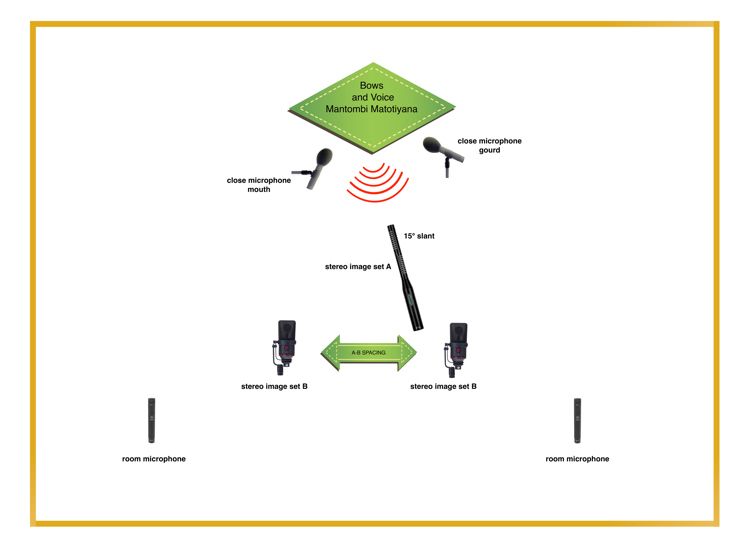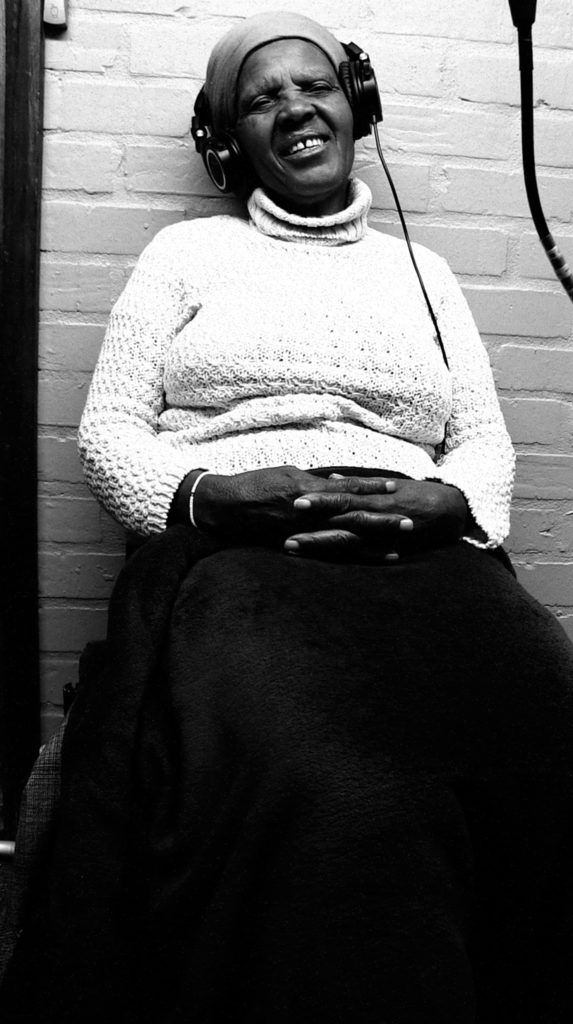DAVID LANGEMANN
On Recording 'Songs of Greeting, Healing and Heritage'
The Mantombi Matotiyana Songs of Greeting, Healing and Heritage recording was a project of the Africa Open Institute (AOI), undertaken with help from the South African College of Music, Music Technology Department which provided the venue and recording facilities. Ms. Matotiyana’s music is not only rich in history and tradition but it is also an immensely beautiful music that deserves archiving for current and future generations to access and enjoy.

Chisholm Recital Hall was a good choice for recording space to capture Ms. Matotiyana’s performances. It has a pleasant and natural acoustic that lends itself to focused and intimate recordings. An added bonus is that it has a recording control room attached with a window in between.

Three microphone techniques were used simultaneously with a plan to blend all three during mixing.

First, a stereo aural image of Ms. Matotiyana’s bow playing and singing. A pair of Neumann TLM 170 microphones was set with cardiod pickup pattern and set up in A-B spaced configuration, one metre apart and about one and a half metres back from her playing position.

Additionally, a Royer SF-24 (stereo microphone with fixed Blumlein configuration) was also used to contribute to this stereo image.

Second, a pair of wide spaced Schoeps MK 2H omnidirectional microphones to capture the room ambience. During mixing it became clear that without this vital component, the recording would have been too sterile sounding.

Finally, two Schoeps MK 21 closely placed microphones were used to add an intimate perspective. One microphone was placed near the bow and the other near Ms Matotiyana’s mouth to capture the soft notes formed in her mouth.

When Ms. Matotiyana played Umrhube bow, the bow microphone was placed near the string and wood parts. When she played the Uhadi bow, that same microphone was moved to the resonating gourd part. These two microphone signals were then delayed by a fraction of a second (32 samples) by ear to time-align them with the others that were further back in space. Foam wind shields were used on both of these microphones in case they were knocked by the bow/stick or bumped in any other way during the recording.
An important note about the stereo image microphone set;

Although Ms. Matotiyana was seated straight in symmetry with the hall, the way the sound projected out from her instrument was not entirely on-axis to the Royer SF-24. We found there was a skewed acoustical axis that needed compensating for. The Royer had to be angled by about fifteen degrees to adjust for this imbalance. Also, as an extra precaution against thumps and bumps often incurred during sensitive acoustic recordings, small foam isolation pads were put under the feet of all the microphone stands.
Two days were spent capturing many inspired and heartfelt performances by Ms. Matotiyana, during which she chose to add some extra vocal layers in order to create a communal feeling for some of her songs. Instead of her spending several hours alone in the main hall whilst we sent playback for each song, we chose rather to invite Ms. Matotiyana to record her vocal layers in the control room.

This shift in workflow allowed us to communicate freely, without the sometimes frustrating communication process that occurs in usual recording sessions involving the often cumbersome talk back microphone-to-headphones systems. Several members of the South African College of Music, led by master musician Dizu Plaatjies, added their voices during this phase. The highly versatile AKG 414 microphone was used to capture these rich voices. Readers can hear the results of these layered voices on the following songs: Wen UseGoli, Kubuhlungu Ukugula, Majola.

The next step was to take these recordings to my studio and start the mixing process. Quite often, moving location during a recording project can benefit the process by unlocking some new perspectives on the material at hand. The various creative, psycoacoustical and cognitive parts of our brains often respond differently to the same musical content once we are placed in a new acoustical environment, thus gaining new valuable insights.
{For any readers unacquainted with the term MIXING, here is a 30 second elevator pitch: By this stage of the recording process, multiple microphones have all been recorded to individual TRACKS (a term born during the era of tape recording) or as audio files on a hard drive (modern day recording). We are able to capture these tracks in perfect synchronization with each other with the aid of a computer Digital Audio Workstation (DAW). This also allows us to decide on a suitable volume balance of microphones or instruments subsequent to the day of recording. This balancing or mixing may be interpreted differently by different people attempting a mix or it may even be mixed several times by the same person until the “perfect” mix is achieved}.
I had at least two objectives for the mixing of “Greeting, Healing and Heritage”.
One was to gently shape the sound to be consistent and pleasing on the ear without losing the vitality and expression of Ms. Matotiyana’s performances. Most microphones have a very different response to acoustic instruments than that of the human ear. The ear is quite forgiving to rough or sharp edges in the sound source whereas microphones are almost too accurate and clinical at times. Typically, bowed instruments also fall prey to this phenomenon. However, one microphone design that comes close to the the human ear’s response is that of the ribbon microphone (Royer SF-24 listed above). To help shape the tracks, we use Digital Signal Processing inside the computer. These software tools are commonly referred to as inserts or plugins.

Please refer to some of the screenshots where plugin processing has been applied to each of the bows. Note the following tone shaping plugins. “Decapitator”, adds some simulated analog character plus it allows one to cut away excess high frequencies, hence the name! This was very useful in taming the stick-on-string brightness of the Uhadi bow. “Oxide”, gave a pleasant amount of simulated analog tape saturation, well suited to the metallic/scraping nature of the Umrhube bow. The Little Labs “VOG” plugin is usually used for enhancing radio and TV voice overs by adding deeper, chest tones to the signal. However, I used this plugin to enhance and bring up some of the lower harmonics of the Umrhube bow. “Smack”, keeps the volume consistent and it also adds some more simulated analog character.

Analog, in the context of audio, is very similar to analog photography whereby the physical distortions, disruptions and artefacts of the medium influence the picture in unpredictable yet pleasant ways. Many audio engineers still swear by the phrase “Analog Rules!”

The other main objective was to heighten and drive the emotional impact of the music as far as possible using all the available software tools. The key to this, I discovered, was the choice of extra reverb enhancement by way of the “Valhalla Vintage Verb” plugin, set to Chamber setting. This made the mouth tones of the Umrhube ring out in a nice way.
When the mixes were reaching completion, groups of signals were sent through an SPL MixDream summing device for more analog treatment.
Final step was the MASTERING process. This is similar to framing a picture or photograph. It provides a final chance to alter the overall tone of each album track, place the tracks in the final playing sequence and make final changes to the track volumes and to the overall loudness of the album.

During this stage, I snuck in one last amount of analog saturation using a small percentage of the “Little Radiator” plugin and also applied an overall low cut filter (57.9 Hz @12 dB/octave slope) to eliminate left over ambient hall rumble.

In conclusion, one can see how several, incremental sonic adjustments were made throughout the process to form the final sonic picture. I hope some of the techniques mentioned above help provide some illumination on the making of “Greeting, Healing and Heritage”, to the music enthusiast – or for any that may be taking on similar themed recordings themselves.
Thank you to Mantombi Matotiyani and Open Africa Institute for inviting us to record this wonderful music.
Special Thanks:
Theo Herbst (SACM, Music Technology Dept.): for venue and equipment Aryan Kaganof: for photographs of recording sessions

Photos by Aryan Kaganof.